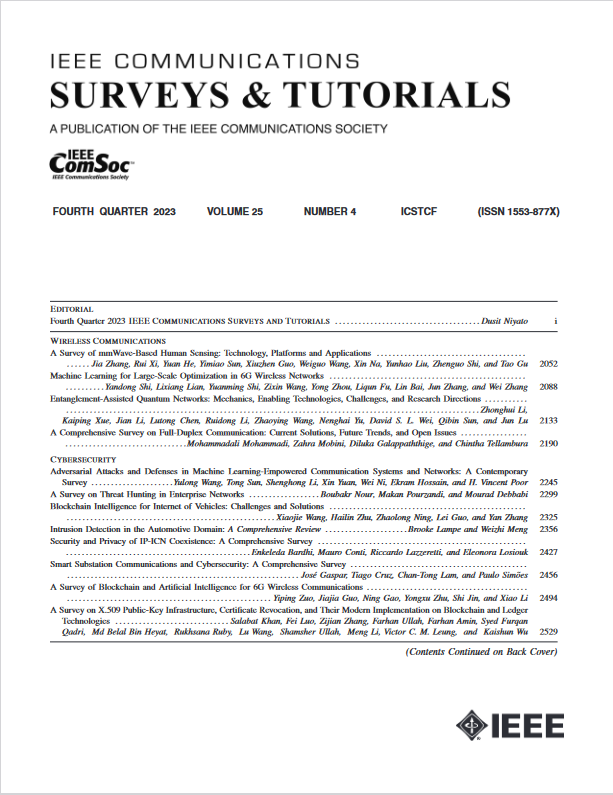近场通信:全面调查
IF 34.4
1区 计算机科学
Q1 COMPUTER SCIENCE, INFORMATION SYSTEMS
引用次数: 0
摘要
多天线技术正朝着更大孔径、极高频率和创新天线类型的方向发展。这种演变促进了未来无线系统中近场通信(NFC)的出现。由于该技术有可能通过在范围域中增加空间自由度(dof)来增强无线网络的容量,因此人们对该尖端技术给予了相当大的关注。在此背景下,对NFC技术的现状进行了全面的回顾,特别关注其i)基本工作原理,ii)通道建模,iii)性能分析,iv)信号处理技术,以及v)与其他新兴应用的集成。具体来说,i)从物理和通信的角度对NFC的基本原理进行了表征,揭示了其与远场通信相比的独特特性。ii)在这些原理的基础上,探索了空间离散(SPD)和连续孔径(CAP)阵列的确定性和随机近场信道模型。iii)基于这些模型,从dof /effective dof (EDoFs)、功率标度律和传输速率等方面综述了近场性能分析的现有贡献。系统地综述了现有的NFC信号处理技术,包括信道估计、波束形成设计和低复杂度波束训练。v)确定了将近场模型与其他有前途的技术相结合的主要问题和研究机会,以推进NFC在下一代网络中的部署。在整个论文中,强调了有希望的方向,以激发未来在NFC领域的研究努力,强调其在无线通信技术进步中的重要性。本文章由计算机程序翻译,如有差异,请以英文原文为准。
Near-Field Communications: A Comprehensive Survey
Multiple-antenna technologies are evolving towards larger aperture sizes, extremely high frequencies, and innovative antenna types. This evolution is fostering the emergence of near-field communications (NFC) in future wireless systems. Considerable attention has been directed towards this cutting-edge technology due to its potential to enhance the capacity of wireless networks by introducing increased spatial degrees of freedom (DoFs) in the range domain. Within this context, a comprehensive review of the state of the art on NFC is presented, with a specific focus on its i) fundamental operating principles, ii) channel modeling, iii) performance analysis, iv) signal processing techniques, and v) integration with other emerging applications. Specifically, i) the basic principles of NFC are characterized from both physics and communications perspectives, unveiling its unique properties in contrast to far-field communications. ii) Building on these principles, deterministic and stochastic near-field channel models are explored for spatially-discrete (SPD) and continuous-aperture (CAP) arrays. iii) Based on these models, existing contributions to near-field performance analysis are reviewed in terms of DoFs/effective DoFs (EDoFs), the power scaling law, and transmission rate. iv) Existing signal processing techniques for NFC are systematically surveyed, which include channel estimation, beamforming design, and low-complexity beam training. v) Major issues and research opportunities in incorporating near-field models into other promising technologies are identified to advance NFC’s deployment in next-generation networks. Throughout this paper, promising directions are highlighted to inspire future research endeavors in the realm of NFC, underscoring its significance in the advancement of wireless communication technologies.
求助全文
通过发布文献求助,成功后即可免费获取论文全文。
去求助
来源期刊

IEEE Communications Surveys and Tutorials
COMPUTER SCIENCE, INFORMATION SYSTEMS-TELECOMMUNICATIONS
CiteScore
80.20
自引率
2.50%
发文量
84
审稿时长
6 months
期刊介绍:
IEEE Communications Surveys & Tutorials is an online journal published by the IEEE Communications Society for tutorials and surveys covering all aspects of the communications field. Telecommunications technology is progressing at a rapid pace, and the IEEE Communications Society is committed to providing researchers and other professionals the information and tools to stay abreast. IEEE Communications Surveys and Tutorials focuses on integrating and adding understanding to the existing literature on communications, putting results in context. Whether searching for in-depth information about a familiar area or an introduction into a new area, IEEE Communications Surveys & Tutorials aims to be the premier source of peer-reviewed, comprehensive tutorials and surveys, and pointers to further sources. IEEE Communications Surveys & Tutorials publishes only articles exclusively written for IEEE Communications Surveys & Tutorials and go through a rigorous review process before their publication in the quarterly issues.
A tutorial article in the IEEE Communications Surveys & Tutorials should be designed to help the reader to become familiar with and learn something specific about a chosen topic. In contrast, the term survey, as applied here, is defined to mean a survey of the literature. A survey article in IEEE Communications Surveys & Tutorials should provide a comprehensive review of developments in a selected area, covering its development from its inception to its current state and beyond, and illustrating its development through liberal citations from the literature. Both tutorials and surveys should be tutorial in nature and should be written in a style comprehensible to readers outside the specialty of the article.
 求助内容:
求助内容: 应助结果提醒方式:
应助结果提醒方式:


